Russell Train Station

This plaque commemorating the Russell Train Station was added to the Historical Plaque Program in 2021, in partnership with the Russell and District Historical Society. This plaque is located at the entrance of the Recreational Trail, at the North end of 1st Avenue in Russell (behind the Russell Library Branch).
Life Before the Station
Without adequate transportation, no community could hope to grow and prosper. By 1882, the closest railway station to Russell was at the Village of Osgoode, 32 km away.
The Opening of the Russell Train Station
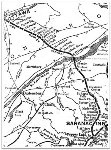
The Russell Train Station on the New York Central (Ottawa-New York) railway opened in 1898. The New York Central railway line connected Ottawa, south through Russell to Cornwall, across the St. Lawrence River to Tupper Lake, New York. There the railway was connected to the vast U.S. railway network. On the Canadian side the station at Finch connected with the Canadian Pacific Railway and the station in Cornwall connected with the Canadian National Railway. Passengers and freight could travel by rail from Russell to anywhere in North America.
The Russell station was a one-storey wooden building painted in the New York Central colours – grey with green trim. Nothing changed life in this small rural community like the opening of this rail link to the outside world. The train station was the social centre of the village. It was where families gathered after weddings to say goodbye to the newly weds departing on their honeymoons. During the first and second world wars, the whole community would assemble at the station to say farewell to the troops leaving to go overseas.
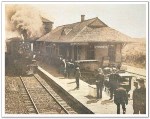
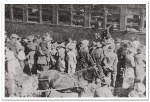
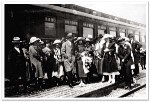 There were 25 cheese factories in the Russell area in 1906. With the construction of the railway, farmers were able to bring their cheese boxes to the Russell station from the local factories to be shipped off to markets in Ottawa, Montreal, Toronto and overseas. John Loucks hauled freight from the Russell railyard to the center of Russell Village as well as to Vars, Metcalfe, Pana and Kenmore. The railway station and the New York Central rail link made Russell Village the commercial centre for the Townships of Russell, Winchester and Osgoode.
There were 25 cheese factories in the Russell area in 1906. With the construction of the railway, farmers were able to bring their cheese boxes to the Russell station from the local factories to be shipped off to markets in Ottawa, Montreal, Toronto and overseas. John Loucks hauled freight from the Russell railyard to the center of Russell Village as well as to Vars, Metcalfe, Pana and Kenmore. The railway station and the New York Central rail link made Russell Village the commercial centre for the Townships of Russell, Winchester and Osgoode.
Before 1900, Concession St. seemed to be a bottomless sea of mud. By May of 1900, gravel was placed from the station down to the center of the village. This is the first record of a gravel road in the western part of Russell Township.
Local Hotels
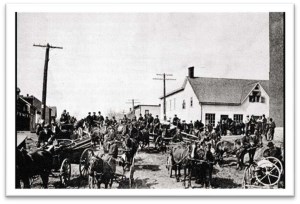
Three hotels were built in the center of the village to accommodate commercial travelers. Itinerant dentists would come once a week on the train until Dr. Proudfoot set up his practice in 1904. Harry York would meet the passenger trains and ferry the travelers and their luggage to one of the hotels. The Commercial Hotel had a large display room, as well as a good livery stable.
The commercial traveler could make the hotel his headquarters and rent a horse and carriage to work the surrounding countryside and towns not served by the railroad.
Industrial Complex at the Railway Station
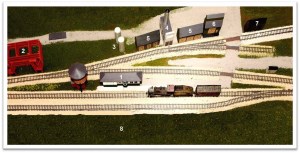
The railway station (1) became the hub for an industrial complex that included the Williams Chemical Company (4), Walker’s Mills (7), and the Canada Milk Products Plant (8). It was also the location for stockyards (2), storage tanks (3), and warehouses (5) and (6).
Williams Chemical Company
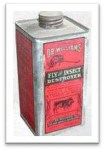
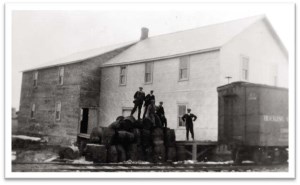 The Williams Chemical Company was founded by Eccles McCaffery. It manufactured Dr. Williams Fly and Insect Destroyer, an insecticide to spray on cattle. Caution was required as heavy spraying could blister a cow’s hide. This unique product was shipped from Russell across Canada. The factory building burned down in 1934 and was replaced by a cement block building.
The Williams Chemical Company was founded by Eccles McCaffery. It manufactured Dr. Williams Fly and Insect Destroyer, an insecticide to spray on cattle. Caution was required as heavy spraying could blister a cow’s hide. This unique product was shipped from Russell across Canada. The factory building burned down in 1934 and was replaced by a cement block building.
The company ceased operation when Eccles McCaffery died in 1938. The building became the warehouse for McCaffery Wholesale a tobacco and confectionary business owned and managed by George McCaffrey. The company operated from this location near the station until 1954.
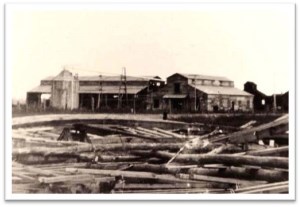
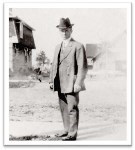 Walker’s Mills
Walker’s Mills
Andrew Walker built a number of mills and storage sheds near the railway station. He had a steam-powered planning mill, a sash and door factory and a grist mill. One of his buildings was big enough to back a freight car in, for loading and unloading. This was one of Russell’s biggest industries. The buildings burned down in 1941. During World War I this factory made ammunition boxes.
Canada Milk Products Plant
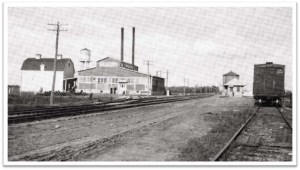
In 1919 the Ottawa Dairy built Canada Milk Products Plant #6 on the other side of the track opposite the Russell railway station. This new plant produced and shipped by rail powdered milk and cream. This new plant offered higher prices for the raw milk and forced the local cheese factories to close. By 1932 the milk plant in Russell was closed and torn down as Nestle opened their plant in Chesterville and there was not enough milk produced in the area to serve both operations.
Imperial Oil
In 1918 Imperial Oil built two gasoline and oil storage tanks along the railway tracks. By this time automobiles were becoming the common form of transportation and required gasoline and oil. Imperial Oil contracted John Loucks to deliver its products to Russell and the surrounding area. Ironically, he delivered these products by “horse power”. The horses were hitched to a wagon or a sleigh depending on the season.
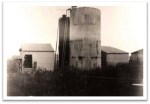
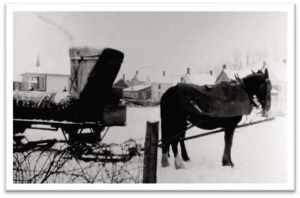
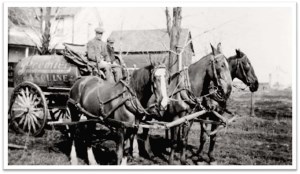
Russell Shale Brick Ltd.
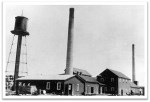

By far the most significant industry in the Village of Russell of the early 1900s was the Russell Shale Brick Ltd with its own siding at the eastern end of the village. The key component to its success was the red shale mined in North Russell. At its peak, this plant had 125 employees and manufactured up to 65,000 bricks per day. Russell brick was one of the most durable bricks in the country and were shipped by rail to Ottawa, Montreal and New York City. The brick factory closed during World War I. It was sold in 1927 and the buildings were torn down.
Other Businesses
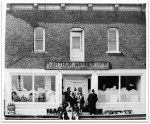 In 1912, Charles F. McArthur from Kenmore built a general store and a feed store on Mill St. with R. Morgan Warner as his junior partner. They had built granary and coal sheds in the industrial park beside the railway station. This general merchandise store was the largest in Russell Township.
In 1912, Charles F. McArthur from Kenmore built a general store and a feed store on Mill St. with R. Morgan Warner as his junior partner. They had built granary and coal sheds in the industrial park beside the railway station. This general merchandise store was the largest in Russell Township.
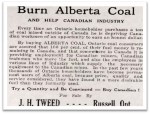
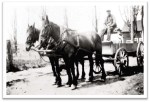
Coal was needed to stoke the kilns at the brick factory and the furnaces of the houses in the area. Almost all the local merchants sold coal: MacEwen and Stephenson, McArthur and Warner and J. Henry Tweed. John Loucks would deliver the coal from the railyard in his large wagon.
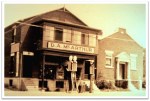
In 1911, Dr. MacDougall bought the first automobile in Russell Village. In 1913 Don A. McArthur sold General Motors automobiles. In the early twenties there were two more dealerships in Russell Village D.M. Robertson sold Fords and T.C. Switzer sold Dodges. By the early 1940’s cars were becoming more frequent on the road than horses.
The End of an Era
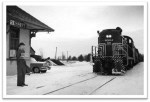
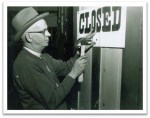 On the 14th of Feb 1957, the last freight train passed through Russell. Station agent, Bernie Campbell met engine 8304 and handed over all the records for the Russell Station and locked the station door for the last time. The New York Central railway facilitated an industrial boom in the Russell area during the first part of the 20th century.
On the 14th of Feb 1957, the last freight train passed through Russell. Station agent, Bernie Campbell met engine 8304 and handed over all the records for the Russell Station and locked the station door for the last time. The New York Central railway facilitated an industrial boom in the Russell area during the first part of the 20th century.

The closing of the railway ended an era of unprecedented growth and Russell Village became a bedroom community for daily commuters to the City of Ottawa. By the Fall of 1957, the tracks were removed and sold for scrap. The section of the right-of-way between Route 200, just west of Russell Village and east to Embrun, has been paved and converted into a multi-purpose recreational trail.
Referenced Materials
The below materials were referenced for this page:
- Churcher, Colin J. 2003. The New York Central in the Ottawa Valley, The Ottawa and New York Railway, Paper prepared for Maple Leaf 2003, National Model Railroad Association Convention in Toronto, July 13-20, 2003. https://churcher.crcml.org/Articles/Article2003_5.html.
- McCaffery, Dr. D.C. 1993. Russell and the New York Central- memories of “the Water Level Route” in Eastern Ontario. Branchline Canada’s Rail Newsmagazine, March edition, p. 8-14.
- Stanley, Wendell. M. 1987 From Swamp and Shanty – the History of Russell Village and the Western part of Russell Township 1827-1987. The Runge Press Limited, Ottawa, Ontario. 173 p.
